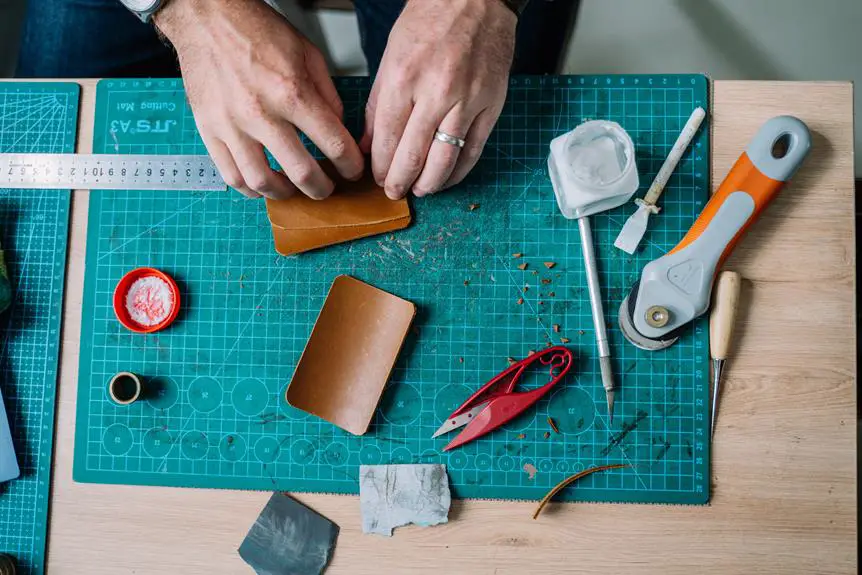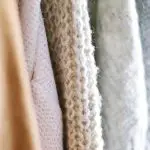You know the saying, 'A stitch in time saves nine'? The same goes for dealing with dried glue on your wood surfaces. Whether it's from a DIY project or an accidental spill, it's important to remove it properly without causing damage.
Luckily, there are 6 easy ways to tackle this issue without harming the wood. From using a vinegar and water solution to employing heat and scrubbing, these methods will have your wood looking good as new in no time.
So, let's dive into these simple yet effective techniques for removing dried glue from wood without a hitch.
Key Takeaways
- Vinegar and water solution can be used to loosen and remove dried glue from wood without damaging the fabric.
- Heat and scrubbing with a heat gun and scraper or brush can effectively remove dried glue from wood surfaces.
- Rubbing alcohol can be used to soften dried glue on wood and gently wipe it away.
- Lemon juice and baking soda paste are natural alternatives that can be used to remove dried glue from wood surfaces.
Vinegar and Water Solution
When removing dried glue from wood without damaging the fabric, start by mixing a solution of vinegar and water. Vinegar offers numerous benefits for cleaning, and when it comes to wood, it's especially friendly. The acidity in vinegar helps to break down the glue without causing harm to the wood or fabric.
To make the solution, mix equal parts of vinegar and water in a bowl or spray bottle. The mild acidity of the vinegar makes it safe to use on wood surfaces, and it won't cause any discoloration or damage to the fabric. Once the solution is ready, apply it directly to the dried glue and let it sit for a few minutes to loosen the adhesive.
After allowing the vinegar and water solution to work its magic, gently scrub the area with a soft-bristled brush or a cloth. The softened glue should start to come off easily without harming the wood or fabric. Once the glue is removed, wipe the area with a clean, damp cloth to remove any remaining vinegar solution.
Using a vinegar and water solution is a simple yet effective method for safely removing dried glue from wood without causing any damage to the fabric.
Heat and Scrubbing
Ready to tackle that dried glue on your wood surface? Using a heat gun can help soften the glue, making it easier to scrape off.
Then, grab a stiff brush and vigorously scrub the remaining residue to restore your wood to its pristine condition.
Heat Gun Method
You can effectively remove dried glue from wood using the heat gun method. Start by setting the heat gun to a low to medium setting and holding it a few inches away from the dried glue on the wood surface. Move the heat gun back and forth over the glue, being careful not to stay in one spot for too long to avoid scorching the wood. The heat will soften the glue, making it easier to remove.
Once the glue is heated, use a scraper or stiff-bristled brush to gently scrub away the softened glue. Continue heating and scrubbing until all the glue is removed.
Then, wipe the wood surface clean with a damp cloth.
Stiff Brush Technique
To remove dried glue from wood using the stiff brush technique, first, ensure you have a stiff-bristled brush and a heat source such as a heat gun or hairdryer available. Follow these steps for effective removal:
- Apply Heat: Start by directing the heat source at the dried glue. The heat will soften the glue, making it easier to remove with the stiff brush.
- Scrub Gently: Once the glue is softened, use the stiff-bristled brush to scrub the affected area. Be gentle to avoid damaging the wood surface.
- Repeat if Necessary: If the glue residue persists, reapply heat and continue scrubbing until the wood is free from glue.
This brushing technique allows for the removal of dried glue without compromising wood preservation. It effectively combines the use of heat and scrubbing to ensure the glue is removed without causing damage.
Rubbing Alcohol
An article determiner should be used to determine the appropriate type of rubbing alcohol to use for removing dried glue from wood without damaging the fabric.
Rubbing alcohol offers several benefits for this task. It effectively dissolves and loosens the dried glue, making it easier to remove. Additionally, rubbing alcohol evaporates quickly, reducing the risk of damaging the wood or fabric.
When applying rubbing alcohol, pour a small amount onto a clean cloth and gently dab it onto the dried glue. Allow the rubbing alcohol to sit for a few minutes to penetrate the glue. Then, use a soft cloth to gently wipe away the softened glue. Avoid excessive scrubbing, as this could damage the wood or fabric.
If necessary, repeat the process until all the dried glue is removed. Remember to test the rubbing alcohol on a small, inconspicuous area first to ensure it doesn't cause any damage.
With these application tips, rubbing alcohol can be an effective and gentle solution for removing dried glue from wood without harming the fabric.
Lemon Juice
When using lemon juice to remove dried glue from wood without damaging the fabric, apply a small amount directly onto the affected area and let it sit for a few minutes to help soften the glue.
Here are some useful tips for using lemon juice as a natural cleaning method and an alternative to other harsh chemicals:
- Lemon Juice Alternative: Lemon juice serves as an excellent alternative to chemical-based glue removers. Its natural acidity helps to break down the glue without causing any harm to the wood or fabric surface.
- Natural Cleaning Methods: Lemon juice is a great option for those who prefer natural cleaning methods. It not only effectively removes dried glue but also leaves behind a fresh citrus scent, making it a pleasant and environmentally friendly choice.
- Caution: While lemon juice is generally safe to use on wood, it's essential to test it on a small, inconspicuous area first to ensure that it doesn't cause any discoloration or damage to the wood or fabric.
Baking Soda Paste
You may already have baking soda in your kitchen, and it can be a powerful ally in removing dried glue from wood without causing any damage. Its gentle abrasiveness allows it to effectively break down glue residue without harming the wood surface.
Simply mix it with water to create a paste, apply it to the affected area, and gently scrub to reveal a clean and glue-free surface.
Baking Soda's Gentle Abrasiveness
To remove dried glue from wood without damaging the fabric, mix a small amount of baking soda with water to create a gentle abrasive paste. Baking soda's mild abrasive nature helps to break down the dried glue without harming the wood or fabric. Here's how to effectively use baking soda for this purpose:
- Create a paste: Mix a small amount of baking soda with just enough water to form a thick paste.
- Apply gently: Using a soft cloth or sponge, apply the baking soda paste to the dried glue on the wood surface.
- Rub and rinse: Gently rub the paste onto the glue in circular motions, then rinse the area with clean water.
Baking soda provides a gentle yet effective way to remove dried glue from wood, making it a go-to option for those seeking wood-friendly cleaning methods.
Safe for Wood Surfaces
An effective way to safely remove dried glue from wood surfaces without causing damage is by using a baking soda paste. To make the paste, mix baking soda with just enough water to form a thick, spreadable consistency. Apply the paste to the dried glue, and let it sit for about 15 minutes.
Then, gently scrub the area with a soft cloth or sponge. The gentle abrasiveness of the baking soda will help lift the dried glue without scratching or damaging the wood surface.
Protective measures and preventative maintenance are essential for wood preservation. Using natural cleaning methods like baking soda paste not only removes dried glue effectively but also helps maintain the integrity of the wood.
With proper care, your wood surfaces can remain beautiful and free from damage.
Effective Glue Residue Removal
For safely removing dried glue from wood surfaces without causing damage, a baking soda paste can be an effective solution. To effectively remove glue residue from wood, follow these steps:
- Create the paste: Mix equal parts of baking soda and water to form a paste with a toothpaste-like consistency.
- Apply the paste: Gently spread the baking soda paste over the dried glue residue on the wood surface.
- Scrub and wipe: Use a soft-bristled brush or cloth to gently scrub the paste into the glue residue. Then, wipe away the paste and residue with a clean, damp cloth.
This method not only effectively removes glue residue but also helps in preventing future glue stains and protecting wood finishes. With this approach, you can successfully restore the wood surface without causing any damage.
Commercial Glue Remover
You can use a commercial glue remover to effectively dissolve dried glue from wood without damaging the fabric. When selecting a commercial glue remover, look for one that's gentle on wood and fabric while still being tough on the glue residue.
Many commercial glue removers are formulated to be safe for use on various surfaces and are designed to break down the adhesive properties of dried glue without causing harm to the environment. Some products are biodegradable and have minimal environmental impact, making them a responsible choice for your DIY projects.
Before using any commercial glue remover, it's important to carefully read and follow the manufacturer's instructions to ensure safe and effective use. When applying the remover, use a soft cloth or sponge to gently work the product into the dried glue, allowing it to penetrate and dissolve the residue. Once the glue is softened, gently scrape it away with a plastic scraper or a soft-bristled brush.
After removing the glue, clean the wood surface with a mild soap and water to ensure all residue is gone.
Frequently Asked Questions
Can I Use These Methods on All Types of Wood, Including Delicate or Antique Wood?
You can safely use these cleaning methods on delicate and antique wood. The techniques are gentle and effective for glue removal without causing damage. Just be sure to follow the instructions carefully for the best results.
Will Any of These Methods Leave a Residue or Odor on the Wood After the Glue Is Removed?
After removing the glue, some methods may leave a residue or odor. Check for residue concerns by wiping the area with a clean cloth. If odor issues persist, try using a mild wood cleaner.
Are There Any Safety Precautions I Should Take When Using These Methods, Such as Wearing Gloves or Working in a Well-Ventilated Area?
When using these methods, it's important to take safety precautions, like wearing gloves and working in a well-ventilated area to avoid inhaling fumes. This is especially crucial for delicate wood, painted or stained surfaces.
Can These Methods Be Used to Remove Other Types of Dried Substances From Wood, Such as Paint or Adhesive Residue?
To remove paint or varnish, use a chemical stripper or heat gun. For adhesive residue or stains, try rubbing alcohol or vinegar. Always test a small area first and wear gloves for protection.
Are There Any Special Considerations for Using These Methods on Painted or Stained Wood Surfaces?
When considering painted wood or stained surfaces, it's important to be cautious with removal methods to avoid impacting delicate wood. For antique wood restoration, test any method on a small hidden area first.
- Why Is Red Velvet Not Red? - April 25, 2024
- How Do You Describe Velvet Fabric? - April 25, 2024
- How Strong Is Velvet? - April 25, 2024







